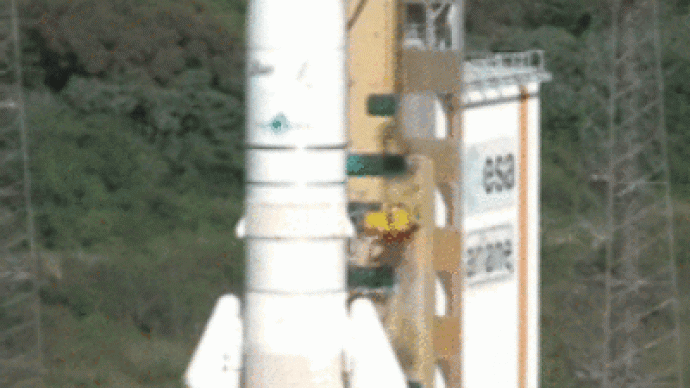Yury Gagarin stone to strengthen Russian-European co-operation in space

Near the French Guianan town of Kourou, the Yury Gagarin stone has been laid, marking a new stage in a long-term partnership between Russia and Europe. The stone has travelled all the way from the Baikonur cosmodrome in Kazakhstan.
This stone became a foundation stone of the launchpad for Russian Soyuz boosters at the Kourou cosmodrome in French Guiana. Over 100 space representatives from both the Russian and the European sides took part in the ceremony.Co-operation between Russia and Europe in the field of space exploration started about 40 years ago.The Europeans say they need the Soyuz to modernise their space programme.“The rocket will be able to take heavier loads to space [launching from] the equator. French companies are getting a great rocket from us,” said Anatoly Perminov, General Director of Russian Federal Space Agency.The Russians will also benefit.Two thirds of about 350 MLN euros needed for the project has been put up by the Europeans.In addition, the proximity of the European space base in Kourou to the equator makes it the ideal place for launching rockets. The earth's rotation creates a slingshot effect that propels the rocket faster, saving fuel and money.Meanwhile, just like the new launch pad will be adapted to fit the tropical climate, the few hundred Russians that are moving here later in the year will have to acclimatise.The inhabitants of Guiana say they welcome the new Slavic community. They hope the Russians working on the space project will also appreciate the country's natural beauty.On the other hand, according to the Russian space industry representatives, the country's space industry helps to create new opportunities for local residents, many of whom live in poverty.Russia's General machinery design office, preparing launchpad for Soyuz rocket, constructs launch complexes, Lunar soil testing devices, and missile defence systems.During WWII, it worked on legendary ‘Katyusha’ multiple-rocket launchers.However, the launchpads for spaceships have become the design office's priority.It was the engineers of the office who produced the launch complex for the first manned space flight in 1961.The design office's founder Vladimir Barmin was one of the pioneers of the Soviet space programme.His son Igor now heads the scientific centre.“We have produced and operate three launch complexes for Soyuz rockets at the Plesetsk cosmodrome. And in Baikonur we have two launch complexes for Soyuz and two for Proton rocket carriers. From 60 to 80% of Russian space launches are conducted from our launch complexes,” said Mr Barmin.Nowadays, the Barmin design office builds a launch complex for the European Space Agency (ESA) in Kourou.“The geographical position of the Guiana space centre allows rockets to carry about a tonne more payload to a Geostationary Earth Orbit. We had to modernize our complex to let it work in new weather conditions. For example, to protect staff from heavy rains, we are making a closed maintenance tower for the French Guiana space centre,” said the head of the Barmin design office.Igor Barmin also stressed the European Space agency's choice confirms Russian-made equipment is the best in the mid-payload class of booster rockets.Russian-made spaceships are expected to be launched from the Russian-made pads in South America sometime in 2009.Meanwhile, around 25% of the people living in Kourou work in jobs directly or indirectly related to the space industry.This is crucially important for the local population, taking into the account the fact that, despite government subsidies, some people in French Guiana still live in poverty.Therefore, there is a lot of enthusiasm concerning the new Russian launchpad. Even in Saramaka, a poor area of Kourou, the space industry has already helped to create new job opportunities for local people.Anyway, construction of the launchpad has already begun, and the first rocket is expected to be launched by December 2008.
You can share this story on social media:












